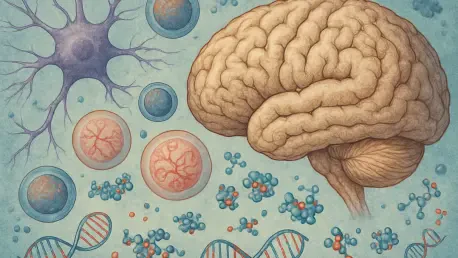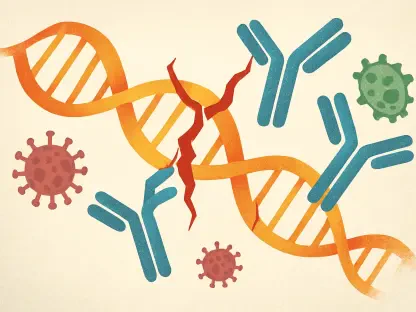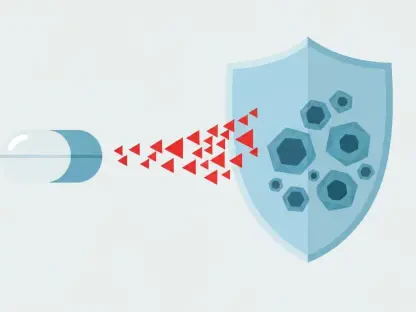In a remarkable stride toward understanding the intricacies of brain aging, Stanford researchers have unveiled critical molecular insights through a study published in Science on July 30, offering new hope for future treatments. Under the leadership of Judith Frydman, the Donald Kennedy Chair in the School of Humanities and Sciences, the team has delved into the cellular processes that falter with age, specifically focusing on proteostasis—the system that maintains protein balance within cells. This research illuminates why cognitive decline and neurodegenerative conditions, such as Alzheimer’s, become more prevalent as years pass, offering a glimmer of hope for innovative treatments. By employing an unconventional yet powerful model organism, the turquoise killifish, the study provides a unique perspective on aging mechanisms that could reshape approaches to brain health. These findings mark a significant step forward, bridging gaps in knowledge about how molecular failures contribute to the aging process and opening new avenues for exploration.
Decoding the Cellular Roots of Aging
The foundation of healthy brain function lies in proteostasis, a cellular mechanism responsible for managing the creation, folding, and degradation of proteins. As aging progresses, this delicate balance deteriorates, leading to the accumulation of harmful protein aggregates often seen in devastating conditions like Alzheimer’s. The Stanford research hones in on this critical breakdown, uncovering the molecular missteps that disrupt protein homeostasis. By examining these failures at a fundamental level, the study addresses a persistent enigma in aging science: why do brain cells lose their efficiency over time? This work not only highlights the vulnerability of proteostasis with advancing age but also sets a crucial benchmark for further investigations into preventing or mitigating the cognitive decline that affects millions globally.
Beyond identifying the general decline of proteostasis, the research reveals specific points where the process unravels, providing a clearer picture of aging’s impact on cellular health. This breakdown is not merely a byproduct of time but a cascade of molecular errors that impair the brain’s ability to maintain functional proteins. Such insights are vital for understanding the broader implications of aging on neurological health. The study’s focus on these cellular underpinnings suggests that targeting specific molecular failures could offer a pathway to preserving brain function. As a result, this research lays a robust groundwork for developing strategies that might counteract the detrimental effects of aging on the brain, potentially transforming how age-related diseases are approached in medical science.
A Rapid Aging Model: The Turquoise Killifish
One of the standout elements of this study is the use of the turquoise killifish, a small vertebrate with an exceptionally short lifespan, as a model for aging research. Native to transient freshwater pools in African savannas, this fish exhibits aging hallmarks similar to humans but in a dramatically condensed timeframe, making it an ideal subject for observing age-related changes. The Stanford team meticulously analyzed the brains of killifish at various life stages—young, adult, and old—to track shifts in protein production processes. This accelerated aging model enabled the researchers to detect molecular disruptions far more quickly than would be possible with longer-lived species like rodents, offering a practical and efficient means to study complex aging dynamics.
The choice of the turquoise killifish also underscores an innovative trend in aging research, where short-lived organisms are increasingly valued for their ability to fast-track scientific discoveries. By comparing protein production components across different age groups of the fish, the study pinpointed specific failures that mirror human brain aging, reinforcing the relevance of this model. These observations provide a unique lens through which to examine the molecular shifts that drive cognitive decline. The efficiency of studying such a rapid aging process not only accelerates the pace of research but also enhances the potential for translating findings into actionable insights for human health, marking a significant methodological advancement in the field.
Molecular Hiccups: Ribosome Dysfunction Unveiled
A pivotal discovery from the Stanford study centers on a specific stage of protein synthesis known as translation elongation, where significant disruptions occur with age. During this process, ribosomes—cellular structures that assemble proteins—read genetic instructions and string together amino acids. In the aging brains of turquoise killifish, these ribosomes were found to frequently stall or collide, leading to a sharp decline in functional protein output and a rise in toxic protein aggregates. This finding offers a critical explanation for why protein quality diminishes over time, a phenomenon observed across various species, including humans, and directly ties molecular dysfunction to broader brain decline.
Further exploration of ribosome dysfunction reveals its profound impact on cellular health, as stalled ribosomes contribute to the buildup of misfolded proteins, a hallmark of neurodegenerative diseases. This disruption is not an isolated issue but a key driver of the aging process in brain cells, amplifying damage over time. The study’s emphasis on translation elongation as a point of failure provides a targeted focus for future research, suggesting that interventions aimed at improving ribosome efficiency could mitigate some aging effects. By linking this specific molecular flaw to widespread cellular consequences, the research offers a deeper understanding of how aging undermines brain function at its core, paving the way for novel therapeutic approaches.
Dissecting Protein-Transcript Decoupling
Another crucial insight from the study is the phenomenon of “protein-transcript decoupling,” a recognized characteristic of aging where the relationship between genetic instructions (mRNA) and actual protein levels becomes disjointed. In younger organisms, mRNA levels typically predict protein abundance, but in aged ones, this correlation vanishes. The Stanford researchers identified ribosome stalling during translation elongation as a primary cause of this mismatch, particularly impacting proteins essential for maintaining genetic stability. This disconnection triggers a ripple effect, exacerbating other aging-related cellular issues and contributing to overall decline.
The implications of protein-transcript decoupling extend beyond a single molecular flaw, illustrating how interconnected aging processes are within cells. As proteins critical for genome maintenance fail to align with their genetic blueprints, cellular integrity suffers, leading to increased vulnerability over time. This finding ties together multiple aging hallmarks, showing how a breakdown in translation can cascade into broader dysfunction. The study’s detailed examination of this decoupling offers a fresh perspective on why aging disrupts so many cellular functions simultaneously, providing a framework for future studies to explore how these molecular misalignments might be corrected to preserve brain health.
Pathways to New Treatments
The practical significance of the Stanford findings cannot be overstated, as they point toward potential therapeutic avenues for combating age-related brain decline. If ribosome stalling is a central cause of proteostasis failure, then enhancing ribosome function or quality control mechanisms could help restore protein balance in aging brain cells. Such interventions hold promise for slowing or even preventing the progression of conditions like Alzheimer’s, where toxic protein aggregates play a destructive role. This research sparks optimism about developing targeted treatments that address molecular root causes rather than just symptoms of neurodegenerative diseases.
Moreover, the study’s insights into broader aging hallmarks, such as protein-transcript decoupling, suggest that anti-aging strategies could have far-reaching benefits beyond specific diseases. By focusing on molecular processes like translation efficiency, future therapies might bolster overall brain resilience against the effects of time. The potential to delay cognitive decline through such targeted approaches represents a significant shift in how aging is addressed medically. As these findings inspire further research, they lay the foundation for innovative solutions that could improve quality of life for aging populations, highlighting the transformative impact of understanding molecular aging mechanisms.
Looking Ahead: Next Steps in Aging Research
Reflecting on the Stanford study, it’s evident that the exploration of brain aging at the molecular level marks a turning point in understanding cognitive decline. The identification of ribosome dysfunction as a key driver of proteostasis breakdown provides a clear target for addressing age-related issues. By leveraging the turquoise killifish, the researchers captured intricate aging processes in a condensed timeframe, offering insights applicable to human health. The study’s focus on translation elongation and protein-transcript decoupling clarifies how interconnected cellular failures fuel brain aging, setting a high standard for scientific inquiry.
Moving forward, the emphasis should shift to translating these molecular discoveries into actionable therapies for neurodegenerative conditions. Future research must explore whether enhancing ribosome function can indeed mitigate proteostasis decline in humans, potentially delaying cognitive impairment. Additionally, expanding studies across diverse species could validate the universality of these findings, ensuring broader applicability. Collaborative efforts in the scientific community will be crucial to develop interventions that target these molecular flaws, ultimately aiming to enhance brain health and extend healthy lifespans for future generations.









